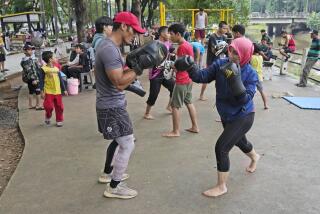Defensive Maneuvers
- Share via
In the war on terrorism, most of us are noncombatants and, hopefully, always will be. But perhaps nothing has done more than Sept. 11 to bring home the realization that if, one day, we had to fight off a terrorist on an airplane--or any assailant anywhere--few of us would have a hope in the world of doing so.
The result is that self-defense courses are seeing a surge in applicants. A relatively new approach gaining popularity is an Israeli martial arts program called Krav Maga, which translates from Hebrew as “contact combat.” It is, essentially, the science of street fighting. And while it’s fine for increasing fitness, and some classes are aimed at cardiovascular health, it’s foremost about survival.
Perhaps Krav Maga’s greatest advantage over other martial arts is that instead of requiring many months of training, often years, it can be effectively learned quickly.
Imi Lichtenfeld, an international champion martial artist from Czechoslovakia, created the system just after World War II. After immigrating to Israel in 1948, Lichtenfeld worked with the government to develop a training program for the Israeli military. Building on years of martial arts experience, Lichtenfeld shifted the Krav Maga curriculum to focus on practical street-fighting applications for saving one’s life.
Darren and Marni Levine opened the first Krav Maga center in the United States in 1996, in Los Angeles. Marni is the highest-ranking female instructor in the world. Darren has a sixth-degree black belt in Krav Maga and is one of the highest-ranked teachers outside of Israel. There are six Krav Maga centers in Southern California, and 100 teaching centers in the United States, with approximately 20,000 students nationwide.
Krav Maga Enrollment Is Up Since Sept. 11
At the Levines’ Krav Maga National Training Center, which has 1,800 members, enrollment is up 20% since the September terrorism attacks. In Philadelphia, Ernie Kirk, who runs three Krav Maga programs in that city, says enrollment has jumped more than 35% since September.
Classes at the Levines’ program--the city’s largest--range from four levels of study under the actual defense system to specific programs for women only, including rape prevention, cardio training and ground fighting. Students begin with an introductory course covering the core Krav Maga movements and fighting techniques. Advanced classes include more physical contact and weapons defense. Training fees range from $75 to $95. Although Krav Maga is based on movements used in the traditional martial arts, its core philosophy is one of utility rather then tradition.
While popular films have immortalized the beauty of a taekwondo flying sidekick and the intense concentration required by martial artists who break bricks, these skills are not especially practical if a rapist, carjacker or terrorist jump you from behind. Forget about a proper karate sparring stance--you simply won’t have time.
Krav Maga, on the other hand, is about the fight.
“Traditional martial arts are much more complex and diversified then simple fighting techniques,” says William Anderson, a master of wing chun, one of many schools of martial arts taught in Los Angeles.
In the serious Oriental programs, such as karate, aikido and taekwondo, a student is simultaneously studying defense, healing arts, breathing and the philosophy behind the system. While a person can learn excellent skills for self-defense in traditional Eastern classes, a good martial arts program is a process that evolves slowly over many years.
A key principle behind many martial arts traditions is that a teacher rarely shares serious fighting methods with a student until he or she has demonstrated a devotion to the art and the right emotional character. This can take years. While students might do some sparring in their early training, it is rare that a school focuses on specific street-fighting techniques. What little sparring there is happens under tournament rules and regulations. On the street, of course, there are no rules.
“A lot of the things that I actually love about martial arts would get me killed on the street,” said Kirk, who holds black belt degrees in taekwondo, go jo, judo and hapkido. “There are inherent self-defense weaknesses in any art that is geared towards competition and sport.”
Darren Levine puts it another way. “Krav Maga does not endorse the fancy stuff.”
Students Learn to Disarm Attackers
At the start of a recent evening class in weapons defense, Darren, who is a deputy district attorney for Los Angeles County, enters the room with a collection of plastic handguns. In the weapons program, students learn techniques that involve moving out of the line of fire and taking control of an aggressor’s weapon before the attacker has the chance to react.
This class is packed with male students this evening. Women are welcome, but often shy away from some of the more physical and bruise-producing drills that occur in the more advanced fighting and defense classes.
A student jams his forearm across Darren’s neck and tightly pins him against the wall while simultaneously pushing a pistol deep into his ribs. “This is about as bad as it gets,” Darren says before describing, step by step, the moves needed to defend oneself from such an attack.
Paul Sklar, an ex-Air Force lieutenant who works as a flight instructor, has been practicing Krav Maga for three years. “One thing I love about this system,” he says, “is that it is designed to work in close quarters, such as an airplane. Before 9/11, I was focusing on fitness, but now I have been taking all the fighting classes. The more people who are trained--from pilot to stewardess to passenger--the better.”
Training includes lots of one-on-one practice drills. While the fighting is monitored, these classes are not for the faint of heart. A student might be working out with a fellow student or punching bag while tennis balls are thrown at him to teach concentration and focus. As students struggle to master basic skills, an instructor might switch off the lights, leaving the students in darkness. Most crimes happen at night.
Students also must prepare for attacks from behind, multiple attackers and learn how to let their body actually absorb a punch or kick. Yes, students do occasionally land a hard blow, even against experienced instructors. Learning how to take that blow, and how you react, can potentially save your life, Krav Maga instructors point out.
No self-defense program offers a guarantee that the training will, in fact, save your life. But a good program should provide the physical and mental training a person needs to act, to the best of their abilities, in any situation.
Martial arts instructors agree that a critical aspect of mastering self-defense is the victim’s state of mind at the time of the attack. Violent criminals often select victims who are easy marks because their attention is divided or distracted at the time: a woman trying to handle groceries and a small child; a person on a cell phone; or a couple engaged with each other.
Instinctive Responses Are Honed in Classes
Besides the physical skills, self-defense courses should help you develop the instinctive responses you will need if attacked unexpectedly. “In an emergency situation you have to train your mind to attack immediately,” Marni Levine said. “You simply can’t afford the pause.”
Such training needn’t take years, but it also doesn’t happen in a few months of classes, experts say.
“One of the most serious mistakes that people make is to take a quick self-defense class for a month or two, creating an illusion of security, and then quit training,” says Peyton Quinn, who runs the Rocky Mountain Combat Applications Program in Lake George, Colo. “While it is absolutely unnecessary to train for hours each day, some sort of ongoing program is vital to keep someone both physically and emotionally ready. Generally people who are willing to attack someone are not only comfortable with getting into a fight, they are training regularly.”
That is a reminder worth remembering.


